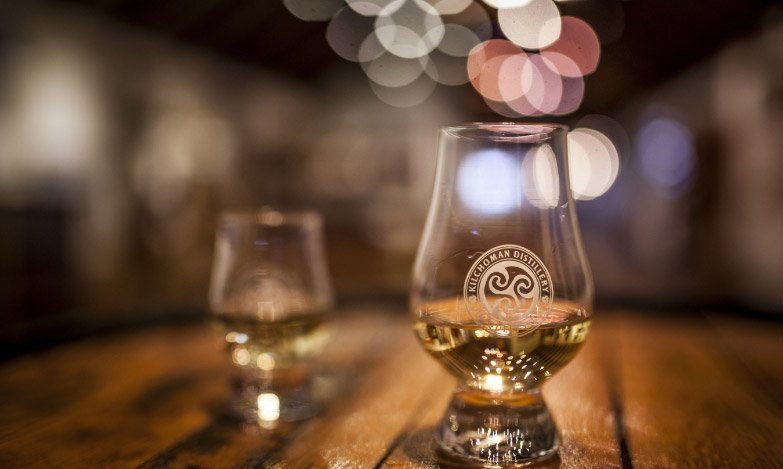The parish of Kilchoman is home to some of Islay’s most fertile ground. It is here, in the fields surrounding the distillery, where we can grow up to 440 tonnes of barley each year. Sown each Spring, once Islay’s 50,000 geese have migrated, our farm team care for the barley over the summer months before harvesting in early September. Harvest time represents the start of the whisky-making process which sees our Kilchoman grown barley malted, distilled, matured and bottled here at the distillery, eventually becoming Islay’s only Single Farm Single Malt Scotch Whisky.
Kilchoman is one of only a few distilleries still practicing traditional floor malting, a process that many of Scotland’s distilleries have outsourced with the arrival of commercial distilling. The process involves soaking the barley in water before it is laid on a concrete floor and regularly turned by hand. This triggers the barley to germinate, allowing for the conversion of starch to fermentable sugars and alcohol. The labour intensive nature of floor malting is a significant factor in its demise, though it remains at the heart of our 100% Islay philosophy.
Cut from Islay’s many ocean-soaked peat bogs and used to smoke the germinating barley, the unique make-up of Islay peat adds waves of rich, maritime smoky character to the whisky. During the peating process the barley absorbs the distinct Islay peat character, adding layers of complexity to the whisky once distilled and matured. After peating and drying the malted barley is left to rest for a minimum of two weeks ahead of milling and mashing.
After peating, the barley is rested before making its journey to the still house for the next stage. Our two custom built hand-operated 1.2 tonne mash tuns are put to work on a daily basis to extract fermentable sugars from the crushed barley grains. This liquid, known as wort, is then drained off to form the basis of the Kilchoman spirit, leaving behind the spent grain known as draff which is fed to our herd of Aberdeen Angus cattle.
Once the sweet, malty and slightly smoky wort is drained from the mash tun, distiller’s yeast is added to trigger fermentation and the creation of alcohol. Our 90 hour fermentation allows for the development of complex esters and the build-up of lactic acid which produces creamy, buttery and particularly fruity notes. This long fermentation when paired with our stills, the smallest on Islay and amongst the smallest in Scotland, create unmatched purity of spirit.
The unique size and shape of our stills produce unparalleled levels of copper contact, allowing for the marriage of earthy, maritime peat smoke and light floral citrus notes which characterises Kilchoman single malt. As with all stages of production at Kilchoman, our stills are carefully controlled by hand, allowing us to adapt to the natural variations of each distillation run.
Our single malt is matured in a combination of cask types sourced from the finest producers around the world. Each barrel contributes a unique character and colour to balance with Kilchoman’s classic peat smoke and floral sweetness. Our two main cask types, bourbon barrels and sherry butts, are sourced directly from the world renowned Buffalo Trace distillery in USA and Bodega Miguel Martin in Spain. As well as bourbon and sherry casks we also fill a number of speciality casks including Sauternes, Red Wine, Rum, Port, Madeira and Cognac casks as well as various secretive experimental casks.
Our range of single malts are all bottled on site at the distillery, eventually completing the journey from barley to bottle. We are very proud to have every stage of production at Kilchoman, from barley growing in the fields around the distillery to bottling on site. Kilchoman single malts are a distillation of people, passion and place.
It is a long established fact that a reader will be distracted by the readable content of a page when looking at its layout. The point of using Lorem Ipsum is that it has a more-or-less normal distribution of letters, as opposed to using ‘Content here, content here’, making it look like readable English. Many desktop publishing packages and web page editors now use Lorem Ipsum as their default model text, and a search for ‘lorem ipsum’ will uncover many web sites still in their infancy. Various versions have evolved over the years, sometimes by accident, sometimes on purpose (injected humour and the like).
It is a long established fact that a reader will be distracted by the readable content of a page when looking at its layout. The point of using Lorem Ipsum is that it has a more-or-less normal distribution of letters, as opposed to using ‘Content here, content here’, making it look like readable English. Many desktop publishing packages and web page editors now use Lorem Ipsum as their default model text, and a search for ‘lorem ipsum’ will uncover many web sites still in their infancy. Various versions have evolved over the years, sometimes by accident, sometimes on purpose (injected humour and the like).


